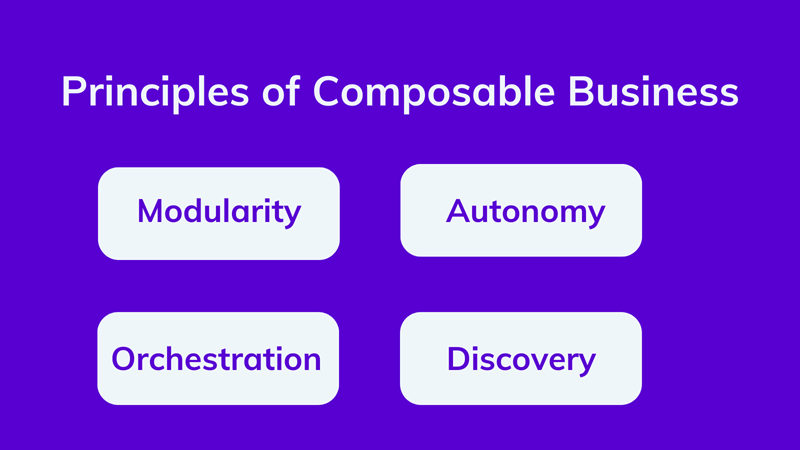Understanding the Essence of Composability: A Strategic Lens
Composability transcends beyond mere technological prowess; it embodies a strategic decision fostering innovation and efficiency. Organizations that have been able to make quick iterations, embracing this mindset shift, are viewing change as an asset rather than a burden.
Unveiling the Power of Composable Architecture
Resource Optimization: Cost Efficiency
Composable systems can help optimize resource allocation by scaling specific components independently, allocating resources based on demand, and reducing costs by reusing existing components instead of creating redundant functionalities.
Agility: Streamlining Operations for Business Responsiveness
Composable architecture facilitates rapid deployment and scaling of applications, enhancing business responsiveness to dynamic market conditions and customer needs.
Scalability: Adapting to the Pace of Business
Composable architecture's scalability empowers businesses to scale resources up or down flexibly, ensuring organizations pay only for the help they utilize and preventing unnecessary expenses during periods of lower demand.
Time-to-Market: Accelerated Development
Composable systems enable faster development cycles. Businesses can quickly market new products or features by leveraging existing modular components rather than building everything from scratch.
Embracing the Principles of Composable Business
The four pillars of composable business – modularity, autonomy, orchestration, and discovery – form the bedrock of a flexible and resilient organization. Breaking down business entities into modular components, ensuring autonomy in change management, orchestrating interactions efficiently, and fostering a culture of continuous discovery become pivotal in this paradigm shift.

Modularity:
Modularity involves breaking down the business architecture into smaller, self-contained modules. Each module performs a specific function and can operate independently, interacting with other modules through well-defined interfaces.
Benefits:
Flexibility: Modularity enhances adaptability by allowing for the easy addition, replacement, or modification of individual modules without affecting the entire system.
Scalability: Businesses can scale specific components independently, allocating resources based on demand and optimizing performance.
Isolation of Issues: Troubleshooting and debugging become more straightforward as issues are isolated to specific modules.
Autonomy:
Autonomy grants a degree of independence to each module or team responsible for a specific function. It allows decision-making authority at the module level, enabling quicker responses to changes without the need for central approvals.
Benefits:
Agile Decision-Making: Teams can make decisions independently, accelerating decision cycles and enabling faster responses to market shifts.
Innovation: Empowering teams with autonomy encourages decentralized innovation, fostering a culture of ownership and creativity.
Responsiveness: Autonomy facilitates quick adaptation to evolving customer needs and market dynamics.
Orchestration:
Orchestration involves coordinating the interactions and workflows between different modules to achieve overall business objectives. It ensures that the various components work together seamlessly.
Benefits:
Efficient Collaboration: Streamlines processes, reduces bottlenecks, and optimizes resource utilization by orchestrating workflows effectively.
Adaptability: Adapts to changing conditions, allowing for the integration of new components, scaling operations, and responding to shifts in demand.
Operational Efficiency: Ensures that workflows remain cohesive and aligned with organizational goals, maintaining operational efficiency.
Discovery:
Discovery fosters a culture of continuous exploration and learning within the organization. It involves actively seeking new technologies, methodologies, and business opportunities.
Benefits:
Innovation and Adaptability: Encourages experimentation, learning from failures, and adapting quickly to emerging trends, positioning the organization to stay ahead of the curve.
Proactive Response: Allows the organization to anticipate and respond to changes in the market, technology landscape, and customer preferences proactively.
Competitive Edge: Commitment to discovery ensures that the business remains agile and can pivot effectively, maintaining a competitive edge.
Cultivating Composable Thinking: A Blueprint for Change
Composable thinking is more than a mindset; it's a guiding philosophy that views each component as a building block, prioritizing changeability over stability. Organizations must shift from a conservative "if it ain't broke, don't fix it" approach to a proactive "design to change" philosophy. This shift in thinking serves as a foundation for conceptualizing and embracing change in the face of economic uncertainties.
Composable Business Architecture: Structuring for Flexibility and Resilience
Composable business architecture transforms foundational business tenets. Dividing business entities into modular components, ensuring independent changeability, defining streamlined interaction mechanisms, and establishing tools for tracking changes lay the groundwork for a flexible and resilient business structure.
Composable Technologies: Tools for Today and Tomorrow
Composable technologies, the enablers of composable business practices, shift the focus from technical APIs to Packaged Business Capabilities (PBCs) or API products. Embracing Mesh App and Service Architecture (MASA), these technologies simplify roles and responsibilities, fostering collaboration among creators, curators, composers, and consumers in a seamlessly integrated composable environment.
Leveraging Existing Technologies with Composable Business
Successful integration of composable thinking with existing digital investments accelerates enterprise digital strategies. The convergence of composability principles with current technology stacks presents opportunities for strategic advancement.
License Management in Composable Architecture: Dispelling Misconceptions
A common misconception surrounding composable architecture is the assumption of increased licensing needs and costs. Contrary to this belief, composable architecture's core principle of abstracting hardware and enabling software-defined resource allocation often leads to a reduced need for licenses compared to traditional infrastructure.
Strategies for License Optimization: Maximizing Cost Savings
Strategies for license optimization within composable architecture include consolidating licenses into dynamic pools, adopting license virtualization, conducting thorough license audits, and engaging in vendor negotiations for flexible licensing models.
Cultivating a Culture of Composability
In the dynamic landscape of composability adoption, the transformation extends beyond technological shifts, necessitating a fundamental organizational culture change. Cultivating a culture of composability is about instilling a mindset that welcomes change as a catalyst for growth. Employee training becomes a cornerstone in this process, ensuring that every member of the organization is equipped with the skills and knowledge to navigate and contribute to the composable framework.
Moreover, leadership buy-in is crucial. The top echelons of the organization must not only endorse but actively champion the principles of composability. Leaders need to communicate the strategic importance of adaptability and set an example by embracing change. Incentivizing innovative thinking becomes a powerful tool for fostering a culture that tolerates and celebrates experimentation and out-of-the-box solutions. Recognizing and rewarding individuals or teams that embody the spirit of composability can be a driving force for cultural transformation.
By exploring these facets—employee training, leadership buy-in, and incentivizing innovation—the article can offer actionable insights for organizations seeking to embed a culture of composability into their DNA.
Security Considerations in Composable Architecture
While the economic benefits of composability are apparent, organizations must navigate the equally critical realm of security. Addressing security concerns in composable architecture involves a multifaceted approach. The article can delve into best practices for securing composable systems, emphasizing the importance of robust authentication mechanisms, authorization protocols, and encryption methods.
Furthermore, compliance standards become paramount. Navigating regulatory landscapes requires organizations to stay abreast of industry-specific and global compliance requirements. The article can guide aligning composable architectures with these standards to ensure economic efficiency, data integrity, and privacy.
By offering practical insights into securing composable architecture, including real-world examples and potential pitfalls to avoid, the article can equip organizations with the knowledge needed to confidently embrace composability without compromising security.
Realizing the Human Element: Composable Teams
Composable thinking extends beyond technology; it permeates the very fabric of teams within an organization. Structuring multidisciplinary, composable teams involves recognizing the diverse skill sets contributing to innovation and efficiency. The article can explore case studies or industry examples where teams with varied expertise successfully collaborated within a composable framework.
Moreover, it can highlight the role of leadership in fostering a collaborative environment. Leaders must encourage open communication, break down silos, and empower team members to leverage their unique skills within the composable architecture. The human-centric dimension of composability is creating teams where individuals are not confined to predefined roles but are encouraged to contribute based on their strengths, fostering a sense of ownership and creativity.
By illuminating the human element of composable teams, the article can inspire organizations to rethink their team structures and capitalize on the diverse talents within their workforce.
Navigating the Future with Composable Confidence
By embracing the principles of composability, organizations can position themselves as agile, resilient entities ready to harness change as a catalyst for innovation and efficiency.
Composability is not merely a technological approach; it's a strategic decision shaping the future of business. The journey involves understanding the essence of composability, unveiling the power of composable architecture, embracing the principles of composable business, and cultivating a culture that fosters adaptability and innovation.
Security considerations, the human element of composable teams, industry-specific applications, and the commitment to continuous evolution further enrich the composable journey. The article encourages organizations to seize moments of composability, learn from real-world examples, and calculate ROI and TCO with practical insights.
As organizations navigate the dynamic landscape of economic uncertainties, composability is a beacon of confidence, guiding them toward a future where adaptability is necessary and a strategic advantage.




